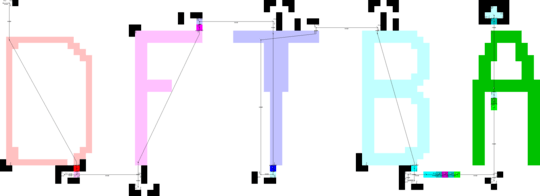8
4
The challenge is to write the most elaborate code, embedded in ASCII art that reads and prints "DFTBA". For example, the following reads DFTBA:
oooooooooo. oooooooooooo ooooooooooooo oooooooooo. .o.
`888' `Y8b `888' `8 8' 888 `8 `888' `Y8b .888.
888 888 888 888 888 888 .8"888.
888 888 888oooo8 888 888oooo888' .8' `888.
888 888 888 " 888 888 `88b .88ooo8888.
888 d88' 888 888 888 .88P .8' `888.
o888bood8P' o888o o888o o888bood8P' o88o o8888o
And the following, in bash prints DFTBA
echo "DFTBA"
The challenge is to write one that does both.
Winning conditions
Valid answers, (all conditions at my discretion)
- Can be clearly read as DFTBA
- Print DFTBA when executed
- Must be functional with no Internet connection
- have letters of equal height
- must not have more than 80 columns
- must not have more than 10 rows
Points (highest sum wins)
- Rows * Columns / 32
- Readability: 25 for legible, 50 for very clear
- 1 point for each different non-whitespace character used
Restrictions
These may be used for something, so all responses are assumed to be released into the public domain. If you can't, or choose not to release your answer into the public domain: post a comment/response to the original question saying "The answer authored and/or shared by me, may not be considered to be in the public domain".
Non-public domain answers are welcome too! Just make sure to specify :-)
What is DFTBA?
It sometimes stands for "Don't Forget To Be Awesome", but not always... Long story... This related song might help explain (or confuse).



The winning criteria is really largest area? That will quickly turn into an arms race of people adding more and more worthless characters to get it bigger. There is really no upper bound on this. – captncraig – 2013-01-25T04:30:25.007
@CMP, revised, thanks :-) – Brigand – 2013-01-25T04:41:32.030
Do upper and lower case characters count separately (as different characters)? – Shmiddty – 2013-02-01T17:23:40.810
Also, what's to stop me from dumping random characters into the code that do nothing? Is that allowed? – Shmiddty – 2013-02-01T17:25:21.947
@Shmiddty, yes, all characters with different ascii codes (excluding whitespace). As long as it runs, that's fine :-) – Brigand – 2013-02-01T22:20:19.320
@FakeRainBrigand what about extended ASCII? http://www.asciitable.com/
– jwbensley – 2013-03-07T23:47:02.400Characters 32-255 are allowed. – Brigand – 2013-03-08T00:45:58.887
@FakeRainBrigand I have posted a new answer for you using both standard and extended ASCII then. Cheers :) – jwbensley – 2013-03-10T22:51:25.780